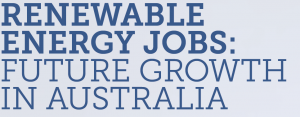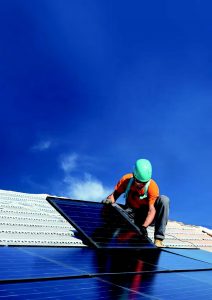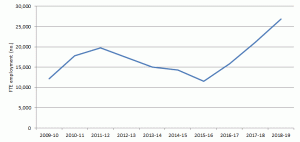

CLIMATECOUNCIL.ORG.AU
Climate Council report 2016
The Climate Council is an independent, crowd-funded organisation providing quality information on climate change to the Australian public.
Key Findings
1. This report compares two scenarios for the national energy sector – business as usual renewable energy growth (34% renewable electricity in 2030) and 50% of electricity derived from renewable sources in Australia by 2030. Both scenarios show increased uptake of renewable electricity will create employment nation-wide.
50% Renewable Electricity (50RE) scenario in 2030 will lead to over 28,000 new jobs, nearly 50% more employment than a business as usual (BAU) scenario.
Jobs are created in the construction, operation and maintenance of renewable energy installations, as well as in related industries.
Across the period 2014-2030, over 80% of full-time employment created by 50RE is additional to the economy.
Job losses in coal fired electricity generation are more than compensated for by increased employment in the renewable energy sector. However, the transition for employees in the fossil fuel sector must be planned well.
2. The net effect on jobs of 50RE is positive across Australia and each individual state: every state will experience
net job growth.
New South Wales (NSW) and Queensland will have the largest net growth in jobs, around 11,000 and 6,000
respectively.
South Australia and NSW will experience the largest per capita jobs growth.
Victoria will see a net gain of around 4,000 jobs by 2030.
3. Unlike other industry transitions such as in automotive manufacturing and steel smelting, which have seen many jobs move offshore, a transition to 50RE will create jobs in Australia.
A large proportion of new jobs gained in the electricity supply sector by 2030 will stem from construction and installation activities related to renewable energy infrastructure. Many of these jobs will be additional to the economy, though location and skills may differ from those currently in demand.
Most states will see half of all new jobs created in rooftop solar photovoltaics (PV): rooftop solar PV jobs are generally accessible, being located in areas where people already live and work.
Utility scale renewable power in regional and remote Australia may well offer opportunities to increase employment in those regions.
Job creation and job transition, together with infrastructure planning, would benefit from a long-term, sector-wide
approach to managing the accelerated renewable electricity deployment.
(See Section 3, p 5-10 for Modelling Approach)
Australian Bureau of Statistics Renewable Energy Employment Data
Main findings
This publication presents estimates of direct full-time equivalent (FTE) employment in renewable energy activities in Australia, from 2009-10 to 2018-19.
2018-19 overview:
- 26,850 jobs
- 27% increase from 2017-18
- 120% increase over 10 years

South Australia’s Virtual Power Plant Teaches 1,100 Homes
South Australia’s Stunning Renewable Energy Transition, and What Comes Next Giles Parkinson 5 November 2019 https://reneweconomy.com.au/south-australias-stunning-renewable-energy-transition-and-what-comes-next-79597/
Ross Garnaut: Three Policies Will Set Australia on a Path to 100% Renewable Energy https://www.theguardian.com/australia-news/2019/nov/06/ross-garnaut-three-policies-will-set-australia-on-a-path-to-100-renewable-energy
See Superpower: Australia’s Low Carbon Opportunity (Black Ink, 2019), book by Professor Ross Garnaut for full details.
Renewable Energy Boom – Up to 60,000 New Australian Jobs by 2030
https://reneweconomy.com.au/renewable-energy-boom-up-to-60000-new-australian-jobs-by-2030-2030/
The Australia Institute 22 November 2018
New analysis from The Australia Institute shows that 53% renewable energy capacity by 2030 would create between 18,000 and 59,000 direct jobs across the country. The analysis is based on the Australian Energy Market Operator’s ‘Fast Scenario’ developed as part of its Integrated System Plan.
The wide range of possible employment outcomes depends largely on how much assembly and manufacturing can be done in Australia.
Ongoing rooftop solar expansion and the installation phase of utility scale solar and wind projects deliver the majority of those positions, but more than 10,000 ongoing jobs could be created, predominantly in regional Australia, in the maintenance and operation of renewable energy facilities under the policy.
“A serious renewable energy target could drive a jobs boom in Australia, particularly in regional areas,” said Rod Campbell, Director of Research at The Australia Institute.
“As employment in the ageing coal power sector declines, new renewable energy projects are already coming online and creating jobs in construction, installation and assembly.
“With strong targets, stable energy policy and support for manufacturing, Australia can clean up its energy sector and generate substantial employment opportunities.
“A large proportion of the jobs being created in renewable energy are outside of the major city centres, which has the potential to give regional Australia a much needed boost.
“In the decade to 2030, there are far more jobs in building new renewable generation than there currently are in operating our aging fossil fuel generators. In the longer term, the operation of utility scale renewables is likely to have similar levels of employment to fossil fuel generators.”
‘Battery of the Nation a Power Surge for Jobs, Guy Barnett says’, Sean Ford 7 October 2019 https://www.theadvocate.com.au/story/6425357/tasmanias-power-surge-big-win-for-revenue-jobs-barnett-says/
Tasmania will get a revenue stream and downward pressure on power prices from the Battery of the Nation project, Energy Minister Guy Barnett says.
“Renewable energy is perhaps Tasmania’s greatest opportunity for the next decade, with our Battery of the Nation pumped hydro plans, new wind farm projects and now a bigger second interconnector set to create thousands of jobs and billions in investment for Tasmania over the coming years,” Mr Barnett said.
“We will provide the nation not just renewable energy, but the most cost-competitive storage options in Australia through our pumped hydro projects, meaning we can supply renewable energy even when the wind isn’t blowing and the sun’s not shining.”
He said the latest independent modelling for the Marinus Link interconnector project estimated up to $6.5 billion would be put into the Tasmanian economy and 2400 jobs created.
Victoria’s renewable energy auction to deliver net benefit of $285 million Sophie Vorrath 14 November 2019 https://reneweconomy.com.au/victorias-renewable-energy-auction-to-deliver-net-benefit-of-285-million-14706/
The Victorian government’s renewable energy auction scheme, which underwrote construction of six new solar and wind farms, is forecast to deliver hundreds of millions in net benefits, a new report has shown.
The Annual Financial Report of the State of Victoria: 2018-19 published by the Auditor General this month, includes an assessment of the Labor Andrews government’s VRES – part of its legislated renewable energy targets of 40% by 2025, and 50% by 2030.
As RenewEconomy reported at the time, the VRES was a resounding success when it wound up in September 2018, allocating 15-year contracts to six renewables generators for a total of 928MW of wind and solar – much more than the 650MW initially targeted.
It helped to deliver such projects as the 336MW Dundonnell wind farm near Warrnambool, and the 180MW Berrybank Wind Farm in the state’s west, which is using Vestas turbines built in Geelong at a repurposed Ford factory.
Australia missing out on huge cuts in emissions through energy efficiency failure
‘Australia Missing Out on Huge Cuts in Emissions through Energy Efficiency Failure’, Naaman Zhou, 12 Jun 2019 https://www.theguardian.com/australia-news/2019/jun/12/australia-could-cut-emissions-halfway-to-paris-target-under-global-energy-standards
Adopting existing global standards for household appliances and factory equipment would also save billions in bills, a new report has found
Western Australian technical plan for integrating high levels of distributed renewables into the grid
‘This technology revolution in renewable energy presents an amazing opportunity for Western Australia given its world class wind and solar resources. With free fuel and low operation costs renewable generation will, over time, put downward pressure on electricity prices and deliver cleaner energy. It is a no-brainer that we should be seeking to optimise the level of renewable energy across our electricity systems.’ (excerpt from Chair’s Foreword’)
Executive Summary of DER Roadmap
The Australian CleanTech Index is now published by Deloitte’s Energy Transition team.
The Australian CleanTech Index provides a measure of the performance of the Australian listed stocks in the Cleantech sector. With over 90 companies following under the coverage of the index and with a combined market capitalisation of over $50Bn, the index presents the only picture of the industry’s growth in a single measure.
Energy Change Institute, Australian national University, article of renewables growth in Australia
‘Three Australian Start-ups Make List of Top 50 Global Cleantech Companies to Watch’, Joshua Hill 1 October 2019 https://reneweconomy.com.au/three-australian-start-ups-make-list-of-top-50-global-cleantech-companies-to-watch-80494/
A Decade of Renewable Energy Investment
A Decade of Renewable Energy Investment, Led by Solar, Tops USD 2.5 Trillion Bloomberg New Energy Finance, September 6, 2019
Global Trends in Renewable Energy Investment 2019, United Nations Environment Program, Frankfurt School of Economics and Bloomberg New Energy Finance
Included for clear depiction of actuality of global transition to renewables